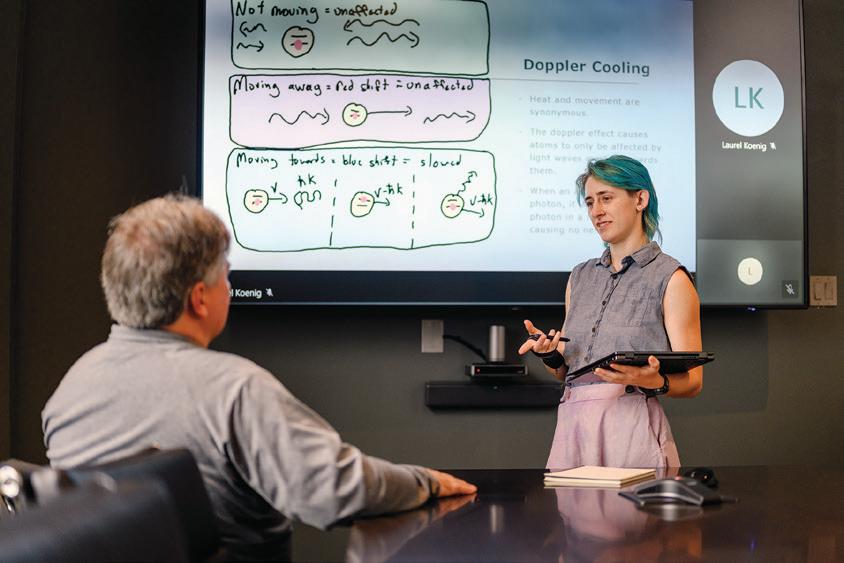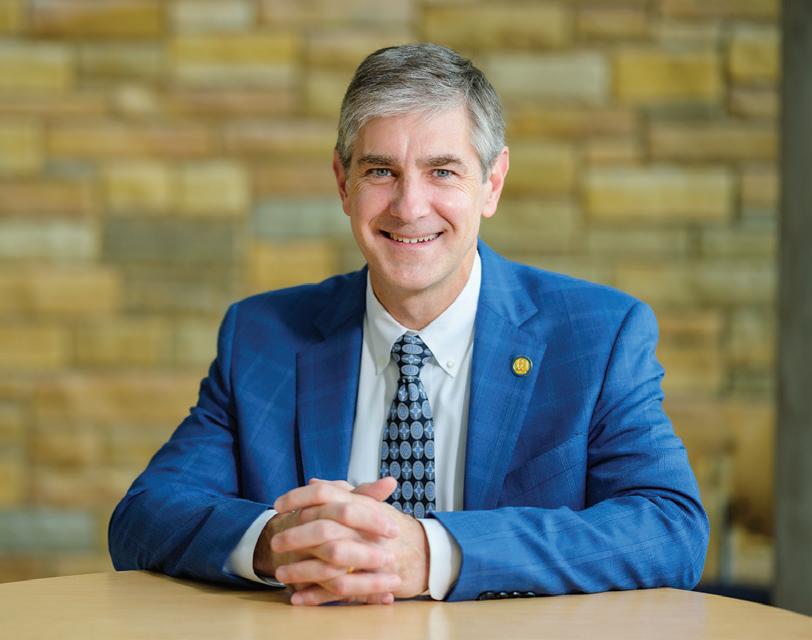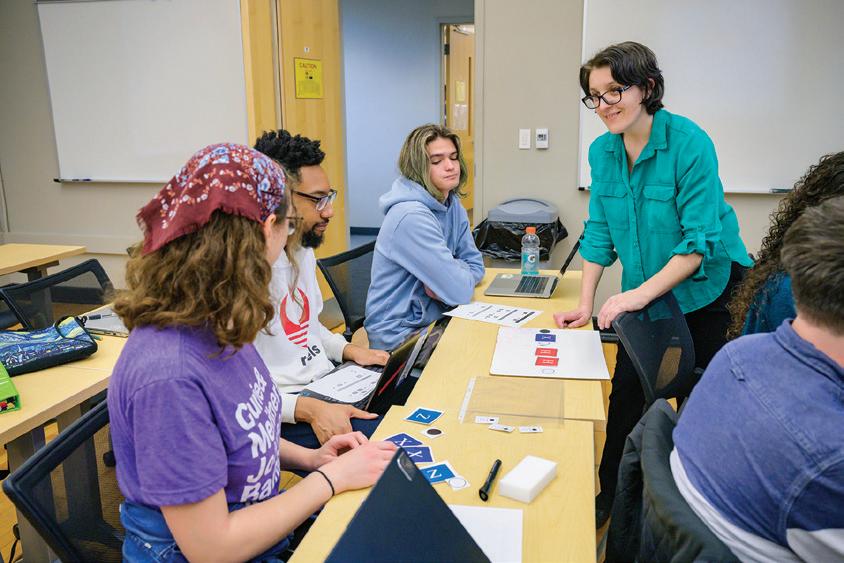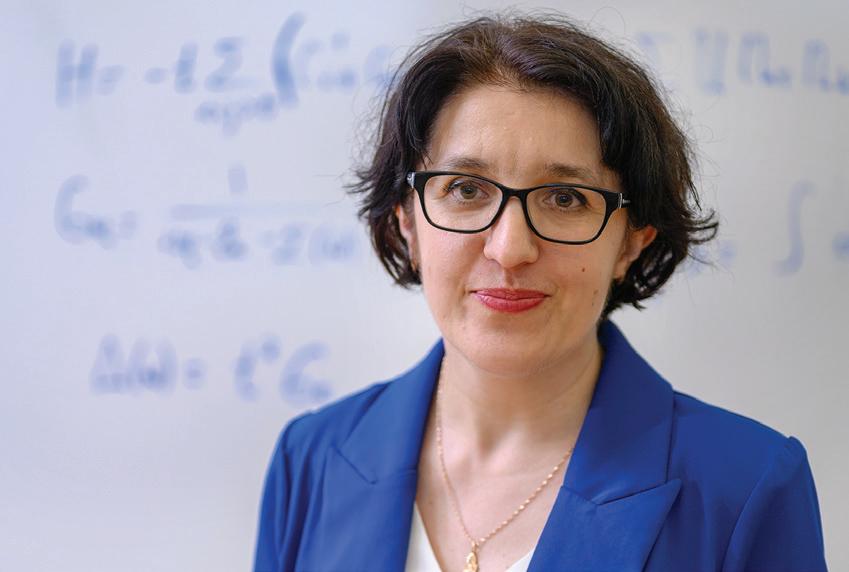
12 minute read
A Quantum Leap Forward

MTSU and professor Hanna Terletska lead research and training efforts to prepare workforce for the future of computing
by Drew Ruble
Say the word “quantum,” and the average person might conjure up images of time travel, à la the television show Quantum Leap from the 1990s.
Told of quantum initiatives now taking place on the campus of MTSU, they might envision a portal tucked away somewhere in a basement lab where researchers disappear and reappear at random intervals.
Spoiler alert: That’s not happening.
The future of quantum computing is indeed the stuff of fantasy and science fiction. And MTSU researcher Hanna Terletska, leader of MTSU’s Quantum Science Initiative and an associate professor of Physics, is doggedly pursuing it. In her research funded by $5.5 million from the National Science Foundation (NSF) and Department of Energy (DOE), Terletska collaborates with scholars from places like Carnegie Mellon University, Oak Ridge National Laboratory (ORNL), and Augsburg University in Germany, using access to the world’s most powerful computers to research quantum materials that hold the promise of new-generation technologies that actually do mimic time travel—or, at least, particles reacting simultaneously in two places at once.
But MTSU’s quantum focus is not only about scientific breakthroughs but also teaching the science. Perfectly aligned with its original charter as a teacher training school founded in 1911, MTSU has positioned itself as the statewide leader in preparing a “ready-towork” workforce for an inevitable future where quantum science and computing revolutionizes industries as far ranging as health care to cybersecurity.
MTSU is also becoming a national leader in training teachers how to teach quantum physics, a crucial educational component in the quest to fully realize quantum’s potential, with Terletska leading national training sessions in quantum.

From Theory to Practice
Terletska describes the discovery of new materials as “a cornerstone of human civilization and development.”
“We now live in the era of quantum materials,” she said. “The potential benefits of 21st-century technologies built on quantum materials and emerging quantum technologies are staggering.”
This includes quantum computers capable of solving complex problems in minutes, problems that currently take years to solve, as well as highly efficient solar cells and room-temperature superconductors that would generate, transmit, and store electricity with almost no loss. Hence, conquering the behavior of quantum materials can, among other benefits, bolster economies, advance quality of life, and address the unprecedented growth in global energy needs. Wired magazine once succinctly described that quantum computing “is about chasing perhaps the biggest performance boost in the history of technology. The basic idea is to smash some barriers that limit the speed of existing computers by harnessing the counterintuitive physics of subatomic scales.”
The seeming “magic” of quantum materials comes from billions of interacting electrons, which at the atomic and subatomic levels start to also have wavelike properties. At this level, quantum physics really kicks in, and electrons start to exhibit quantum effects like tunneling, interference, entanglement, and topological order. Research in this field requires complex many-body numerical algorithms and access to powerful supercomputers.

Admittedly, at present, a lot of this is still theory. There is a race going on to create the physical processor that’s eventually going to make this type of computing possible. Companies like Microsoft, Google, and IBM are investing big in quantum technology, and announcing major breakthroughs seemingly every month. Founder and lead of Google Quantum AI Hartmut Neven stated recently that his company is “optimistic that within five years we’ll see real-world applications that are possible only on quantum computers.”
Suffice it to say, it’s coming. And when it does, it will turn established ways of doing things into primitive history. But getting from science fiction and fantasy to this new reality requires reinterpreting the math and learning new physics. It also requires teaching it to a new generation of scholars.
That’s where Terletska and MTSU enter the picture.
“We need to educate people how to use it,” said MTSU College of Basic and Applied Sciences Dean Greg Van Patten. “We need to educate people on basically a new type of science—the basic rules of quantum mechanics that lead us to be able to do this kind of processing.”
The future of quantum computing is indeed the stuff of fantasy and science fiction.
To bring about this needed change in curriculum, MTSU in 2023 launched the MTSU Quantum Science Initiative, which not only focuses on remaining at the forefront of the scientific research but outlines two other major goals. First, on quantum research in quantum materials and quantum information, and educating a future workforce ready to tackle the new realities of futuristic computing. And, additionally, becoming a leader at “training the trainers” so other institutions can fast-track the teaching of this new-age thinking.
That starts with creating a curriculum for teaching quantum mechanics and computing. The work is interdisciplinary in nature, growing out of physics where these quantum concepts were discovered, but branching into computer science, mathematical sciences, and even chemistry.
It wasn’t long ago that there was no roadmap for how to educate students in this field. Academics like Terletska have changed all that. At MTSU, Terletska developed educational materials to bring students from “ground zero” and start educating them about quantum mechanics.
It placed her in the national spotlight.

“Her work in this field has been a big deal,” Van Patten said. “She did some preliminary work here, and then, based on that work and her ideas, was granted in 2020 a nearly $500,000 Early Career Development CAREER grant from the National Science Foundation—a highly respected five-year award that most often only go to junior faculty at top-tiered research institutions. . . . That’s a marker very early on in somebody’s career that they are poised to be a leader. And that’s the federal government investing in them as a leader.”
Not resting on those high laurels, Terletska used her newfound attention and resources to accelerate collaborations and ensure her research and awards resulted in the education of the next generation of scientists. For starters, along with Professor Ron Henderson, head of the MTSU Physics and Astronomy Department, she built the University’s Quantum Science and Computing concentration in Physics that began in fall 2024.
“Before Hanna came to MTSU, there was no mention of quantum science outside of two courses taught in physics,” Henderson said about Terletska’s arrival in 2017. “There is significant national interest in quantum computing, but the expertise required to contribute in this area of research is beyond the training of most faculty. Hanna took the initiative to expand her knowledge from quantum mechanics and quantum materials to quantum computing.”
Terletska has also conducted numerous “train the trainer” seminars (see accompanying sidebar ) so that the information she’s producing reaches K–12 teachers who can start preparing students with these ideas early on. And she’s provided her materials and made them available to other universities and colleges. She developed plans to create a center for quantum studies at MTSU, and her latest DOE grant proposal envisions a collaboration on quantum material research with other universities in middle Tennessee and to produce a workforce specifically aimed at supporting labs like Oak Ridge, where they need this kind of technical training that otherwise is not yet available.

The Race Is On
MTSU is currently seeking state dollars to support its Quantum Initiative. Its pitch is that the University’s strong efforts in workforce development and teacher education perfectly complement other quantum efforts now occurring at other universities in the state.
The nearby University of Tennessee–Chattanooga (UTC) has already benefitted from a significant investment made by the state of Tennessee, as well as from the city of Chattanooga. The University of Tennessee system also boasts the Appalachian Quantum Initiative. But MTSU has reached a critical mass with seven federal grant awards already that additional state support could further build upon to expand quantum efforts in Tennessee.
MTSU is poised to make even bigger contributions in other needed pillars of quantum investment, with strengths already in quantum algorithms and quantum materials along with the aforementioned creation of a quantum workforce development and training program—aka, the education piece. Van Patten said only when all of these moving parts work together can the state of Tennessee truly become a national leader on this most groundbreaking scientific advancement in modern history.
Van Patten has put his college’s money where his mouth is, investing precious (and limited) University capital in the MTSU Quantum Science Initiative.
So too has the MTSU Provost’s Office, which has committed significant funding to the initiative. Regarding outside investment, Terletska alone has garnered $5.5 million from seven grants in recent years, almost all of her funding sources reflecting federal investment.
At present, quantum science is a rapidly advancing field that is beginning its transition from the laboratory to the marketplace.

But more is needed to ensure Tennessee capitalizes on its quantum head start. As such, MTSU has requested additional funding and support from the state.
“We are asking the state to recognize this leadership position and to invest in it,” Van Patten said. “We think it’s going to be great for the state of Tennessee. We think it’s going to position Tennessee as a leader in the region for quantum . . . drive the state’s economy, and drive Tennessee forward.”
Governments and large multinational companies around the world have launched significant quantum material research initiatives in recent years and have invested heavily in related technologies and education. In 2018, the U.S. government signed a Quantum Initiative Act, making quantum material research a national priority. Over the last decade, numerous quantum research centers have emerged all across the U.S.
“If we want America to be the first to explore and understand the quantum-scale frontiers of science, then we must support the excellence that exists at institutions all over our country,” said Sean L. Jones, NSF assistant director for mathematical and physical sciences. “NSF’s support for these new projects demonstrates our commitment to nurturing innovative ideas and people, wherever they are.”
Van Patten said the ongoing research on quantum materials, education, and information science at MTSU not only underscores that national priority but squarely hits all three parts of his college’s mission: preparing students at all levels for successful careers across a range of scientific and technical fields, promoting scholarship and scientific inquiry, and addressing key scientific challenges that face our nation.
“At present, quantum science is a rapidly advancing field that is beginning its transition from the laboratory to the marketplace. It has the potential to revolutionize certain computational tasks, including cybersecurity, and I’m excited that MTSU is involved in moving this field forward,” he said.
MTSU clearly wants and deserves a bigger piece of the action. Now classified by Carnegie as an R2 research university, characterized by “high research spending and doctorate production”—a recognition earned by only 3% of colleges and universities nationwide—MTSU is ready and able to expand its expertise in quantum sciences. With clear goals, a solid foundation, and a national leader in Terletska leading the charge, MTSU is also poised to help the state of Tennessee make a giant leap forward.

Training the Trainers
At the American Association of Physics Teachers winter 2025 meeting in St. Louis in mid-January, MTSU’s Hanna Terletska— along with Stewarts Creek High School teacher Robert Haddard (’14, B.S.; ’25, Ph.D.) and MTSU Department of Physics and Astronomy scholar and researcher Paulson K. George—led a successful workshop, “Train the Trainer: From Atoms to Quantum Computers.”
The four-hour session provided essential guidance on how to introduce quantum mechanics and quantum computing concepts to high school educators. This workshop was also part of Terletska’s efforts under her National Science Foundation-funded (three-year $800,000) ExpandQISE award.
The workshop attracted participants from Stony Brook University, Purdue University, the University of Denver, University of Tennessee–Chattanooga, and others.
Terletska, an MTSU associate professor in Physics, has led numerous pioneering quantum education initiatives, including STEM camps in 2023–24 for approximately 65 high school students, equipping them with fundamental quantum skills and exposure to cutting-edge quantum technologies.
She also conducted the train the trainer workshop when MTSU hosted the Tennessee section of the American Association of Physics Teachers in spring 2024, engaging faculty representatives from Christian Brothers University, the University of Tennessee, UTC, Tennessee Tech, and Austin Peay State University.

Home Schooled
Originally from the Drohobych, Lviv, region of Ukraine, Hanna Terletska is a firstgeneration college student who has not forgotten her roots.
Terletska—who earned her M.S. at Minnesota State, then a Ph.D. at Florida State University, followed by several postdoctoral trainings at the Brookhaven National Lab, Louisiana State University, Ames Lab, and University of Michigan, and finally the faculty position at MTSU in 2017—recently launched the STEM with UKRAINE Initiative, partnering with Ukrainian and American universities and institutions to bring and sustain quantum computing education for an international population under the burden of an ongoing war with Russia.
Since its inception, the partnership grew to include 29 Ukrainian universities and institutions, 10 U.S. institutions, and one Canadian university and successfully guided 100 participants—coming from an array of academic backgrounds and countries such as Canada, China, India, Italy, Ukraine, and the U.S.—to earning completion certificates at the end of May 2024.
The initiative is part of Terletska’s larger $800,000 National Science Foundation “ExpandQISE” grant, which she explained aims “to open up access to quantum training to all interested in quantum, welcoming participants from diverse educational backgrounds and levels of expertise, including high school teachers and seasoned faculty members, to a rich exchange of ideas and perspectives.”










